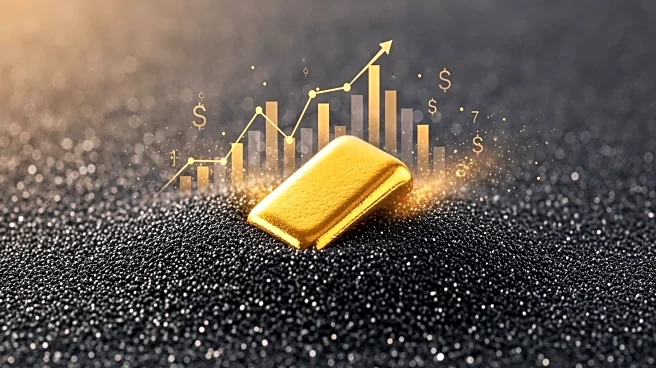What's Happening?
Gold prices have reached a new record high of $3,814.77 per troy ounce in September 2025, marking a 44.73% increase from the previous year. This surge surpasses the inflation-adjusted high from January 1980, when gold was priced at $850 per ounce, equivalent
to approximately $3,590 today. The increase in gold prices is attributed to economic instability, inflation fears, and geopolitical events, which have been significant drivers since 2000. Historically, gold prices have been influenced by various economic and geopolitical conditions, and the current rise reflects ongoing concerns about the U.S. economy and global tensions.
Why It's Important?
The rise in gold prices is significant as it indicates heightened economic uncertainty and inflation fears, prompting investors to seek safe-haven assets like gold. This trend impacts various stakeholders, including investors, central banks, and industries reliant on gold. As gold prices increase, it may lead to higher costs for industries using gold in manufacturing, such as electronics. Additionally, central banks may adjust their monetary policies in response to these economic signals, potentially affecting interest rates and currency values. The surge in gold prices also reflects broader geopolitical tensions, influencing global trade and investment strategies.
What's Next?
If economic instability and inflation fears persist, gold prices may continue to rise, further impacting investment strategies and central bank policies. Investors might increase their holdings in gold, anticipating continued economic uncertainty. Central banks could respond by adjusting interest rates or increasing gold reserves to stabilize their currencies. Additionally, industries reliant on gold may seek alternative materials or adjust pricing strategies to mitigate rising costs. The ongoing geopolitical tensions could also influence future gold price movements, as countries navigate trade relationships and economic policies.
Beyond the Headlines
The current rise in gold prices highlights deeper economic and geopolitical challenges, including the impact of inflation and currency fluctuations on global trade. As countries grapple with these issues, the role of gold as a stable investment becomes increasingly important. This situation underscores the need for strategic planning by investors and policymakers to address potential long-term economic shifts. The historical context of gold prices also reveals patterns that may guide future investment decisions, emphasizing the importance of understanding market dynamics and geopolitical influences.














